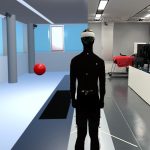Overground Walking in a Fully-immersive Virtual Reality: Effects of Continuous Walking on Dynamic Balance in a Cohort of Young and Elderly People.
Aim and Research Question(s)
The aim of this master's thesis was to evaluate whether there is an adaption of the dynamic balance and spatiotemporal gait parameters of healthy young and elderly people while wearing a Virtual Reality head-mounted display (VR-HMD) and walking continuously in a fully-immersive Virtual Reality and whether there are differences in the adaption of the dynamic balance and spatiotemporal parameters between younger and elderly people.
Background
Gait disorders are associated with chronic disability in older adults [1]. Due to demographic change, new effective therapies to treat age-related mobility loss are becoming increasingly important. Recently, VR-HMDs have gained interest as a gait rehabilitation tool. However, before VR can be used in rehabilitation without restrictions, it is essential to determine if VR-HMDs alter gait in older adults. Indeed, gait is an unstable motor task where the center of mass (COM) is displaced inside and outside the base of support (BOS) (dynamic balance) [2]. Until now, no evidence examined if balance changes during prolonged walking with a VR-HMD in young and older adults. As adaptation generally slows from healthy aging, older adults may require more time to adapt dynamic balance to a VR-HMD.
Methods
3D gait analysis data of 15 healthy younger (26,5 ± 2,5 years) and 16 older adults (66,4 ± 4,2 years) were collected with a Vicon Nexus System during walking for ten minutes with a VR-HMD (Meta Quest 2). Outcomes included the Margin of Stability (MOS) and spatiotemporal parameters. The MOS quantifies dynamic balance as the distance between the extrapolated COM and the BOS. To assess adaption, the ten-minute trial was divided into two intervals. A between and within-repeated measures ANOVA was run in SPSS.

Results and Discussion
The results showed an interaction effect in step width variability and group differences in double support ratio and mediolateral MOS, which indicates a different adaption strategy between younger and older adults. Over time all individuals adapted to a cautious gait pattern (i. e. reduced cadence, increased double support and step time). Further, the anteroposterior MOS increased over time as values got less negative.
Conclusion
The results indicate a different adaptation strategy between younger and older adults. However, according to former evidence, an adaption period of ten minutes may not be long enough to observe an adaptation in dynamic balance. Further research, with longer periods but similar walking conditions, should be taken to get more insights in adapting to VR during overground walking.
References
[1] Agborsangaya et al. (2013). Multimorbidity prevalence in the general population: The role of obesity in chronic disease clustering. BMC Public Health, 13(1), 1161. [2] Siragy, T., & Nantel, J. (2018). Quantifying Dynamic Balance in Young, Elderly and Parkinson’s Individuals: A Systematic Review. Front. Ag. Neurosc., 10, 387. [3] Hof et al. (2005). The condition for dynamic stability. J. of Biom., 38(1), 1–8.